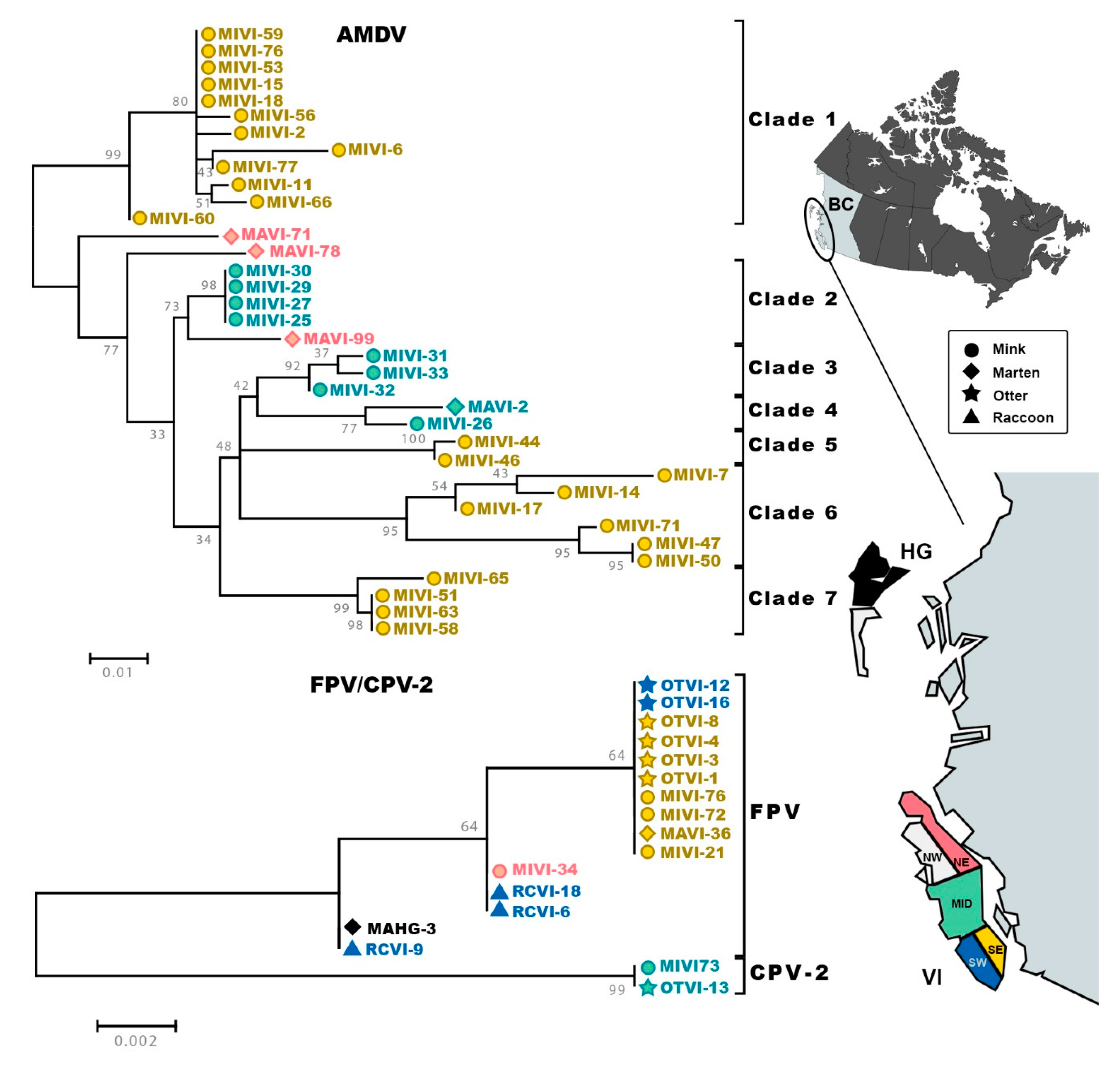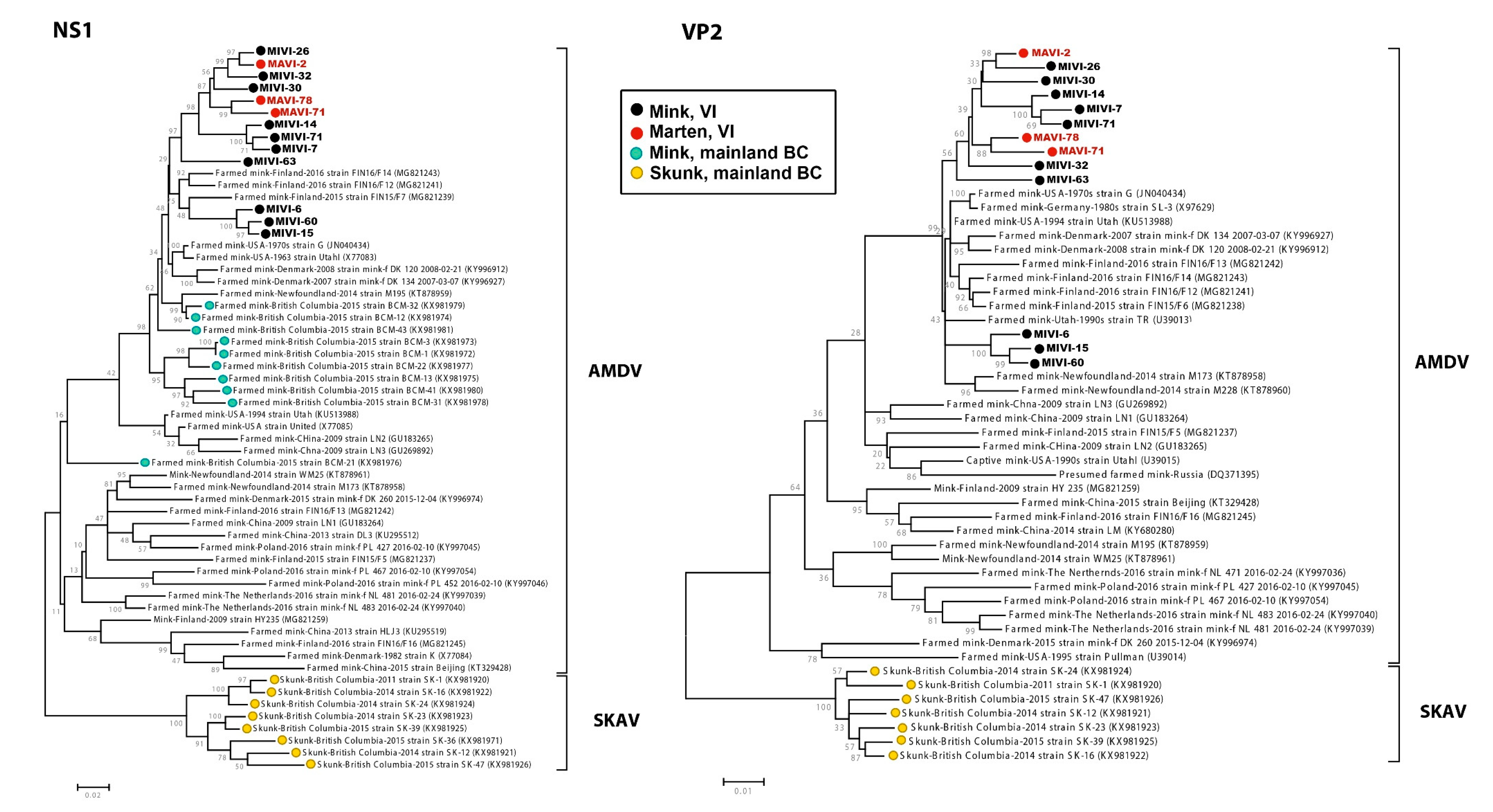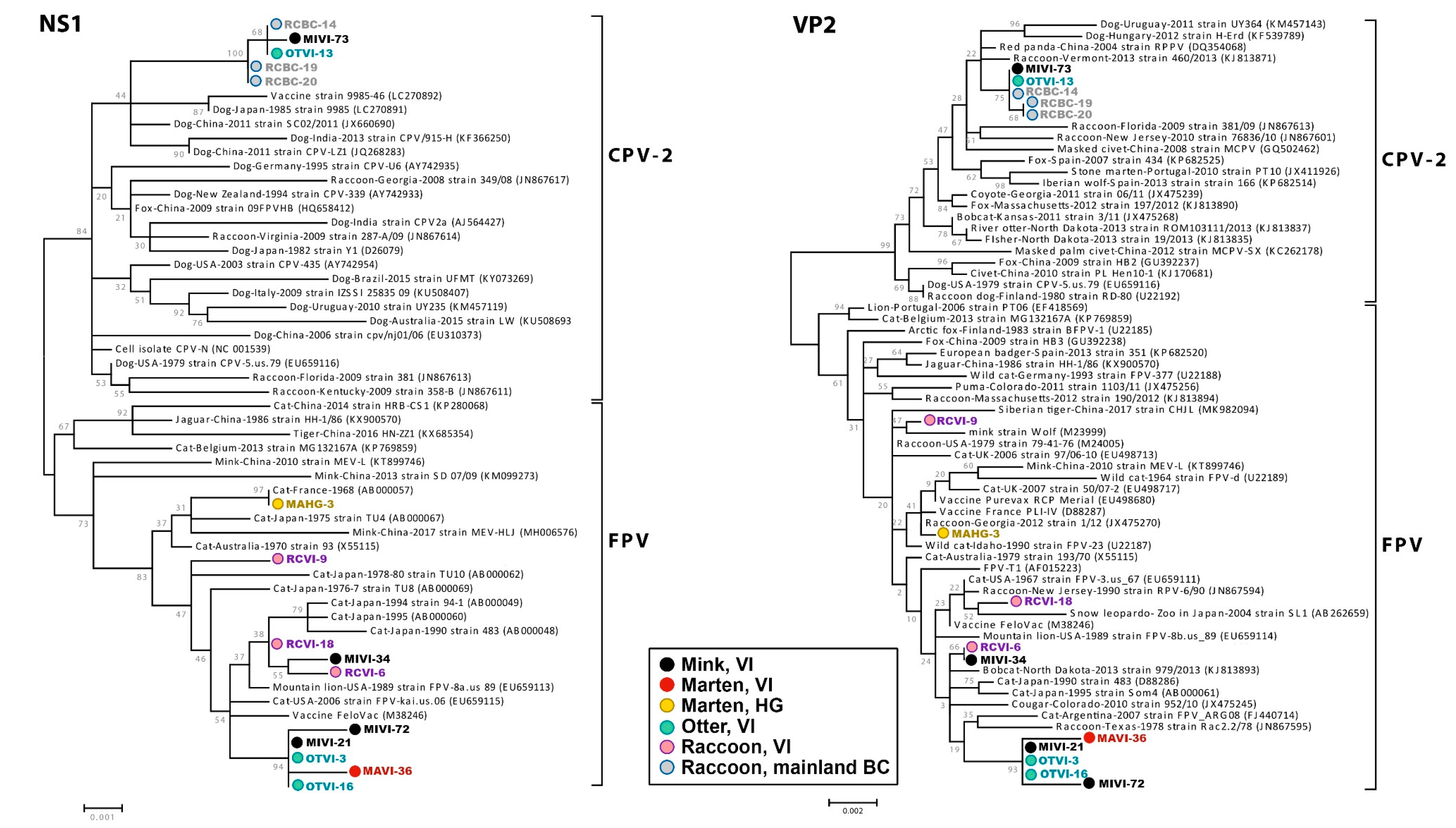Ecology and Infection Dynamics of Multi-Host Amdoparvoviral and Protoparvoviral Carnivore Pathogens
Abstract
1. Introduction
2. Materials and Methods
2.1. Sample Collection
2.2. Screening and Sequencing
2.3. Sequence Analysis
2.4. Statistical Analyses
2.5. Data Availability
3. Results
3.1. Viral Prevalence and Host Distributions
3.2. Spatial Distributions
3.3. Molecular Epidemiology of Parvoviruses in Insular BC
3.4. Molecular Epidemiology of Parvoviruses in a Global Perspective
4. Discussion
4.1. Ecology and Evolution of Parvoviruses in Insular BC
4.2. Epidemiology and Ecology of Parvoviruses and Their Hosts
5. Conclusions
Supplementary Materials
Author Contributions
Funding
Acknowledgments
Conflicts of Interest
References
- Sato, J.J.; Hosoda, T.; Wolsan, M.; Tsuchiya, K.; Yamamoto, M.; Suzuki, H. Phylogenetic relationships and divergence times among mustelids (Mammalia: Carnivora) based on nucleotide sequences of the nuclear interphotoreceptor retinoid binding protein and mitochondrial cytochrome b genes. J. Zool. 2003, 20, 243–264. [Google Scholar] [CrossRef] [PubMed]
- Law, C.J.; Slater, G.J.; Mehta, R.S. Lineage diversity and size disparity in Musteloidea: testing patterns of adaptive radiation using molecular and fossil-based methods. Syst. Biol. 2018, 67, 127–144. [Google Scholar] [CrossRef] [PubMed]
- Colella, J.P.; Lan, T.; Schuster, S.C.; Talbot, S.L.; Cook, J.A.; Lindqvist, C. Whole-genome analysis of Mustela erminea finds that pulsed hybridization impacts evolution at high latitudes. Commun. Biol. 2018, 1, 1–10. [Google Scholar] [CrossRef]
- Dawson, N.G.; Cook, J.A. Behind the genes: diversification of North American martens (Martes americana and M. caurina). In Biology and Conservation of Martens, Sables, and Fishers. A New Synthesis; Cornell University Press: Ithaca, NY, USA, 2017; pp. 23–38. [Google Scholar]
- Dawson, N.G.; Colella, J.P.; Small, M.P.; Stone, K.D.; Talbot, S.L.; Cook, J.A. Historical biogeography sets the foundation for contemporary conservation of martens (genus Martes) in northwestern North America. J. Mammal. 2017, 98, 715–730. [Google Scholar] [CrossRef]
- Hatler, D.F.; Mowat, G.; Beal, A.M.M. BC Furbearer Management Guidelines: Ermine, Long-Tailed Weasel and Least Weasel. Available online: http://www.env.gov.bc.ca/fw/wildlife/trapping/docs/weasel.pdf (accessed on 27 December 2019).
- Committee on the Status of Endangered Wildlife in Canada (COSEWIC) Assessment and Status Report on the Ermine Haidarum Subspecies, Mustela Erminea Haidarum, in Canada. Available online: http://publications.gc.ca/site/eng/9.801421/publication.html (accessed on 27 December 2019).
- Golumbia, T.E. Introduced Species Management in Haida Gwaii (Queen Charlotte Islands). In Proceedings of the a Conference on the Biology and Management of Species and Habitats at Risk, Kamloops, BC, Canada, 15–19 February 1999; Volume 1, pp. 15–19. [Google Scholar]
- Hatler, D.F.; Beal, A.M.M. BC Furbearer Management Guidelines: Mink. Available online: http://www.env.gov.bc.ca/fw/wildlife/trapping/docs/mink.pdf (accessed on 27 December 2019).
- Hatler, D.F.; Nagorsen, D.W.; Beal, A.M.M. Carnivores of British Columbia; The Mammals of British Columbia Series; Royal British Columbia Museum: Victoria, BC, Canada, 2008; Volume 5. [Google Scholar]
- Gaston, A.J.; Golumbia, T.E.; Martin, J.L.; Sharpe, S.T. Lessons from the Islands: Introduced Species and What They Tell Us about How Ecosystems Work. In Proceedings of the Research Group on Introduced Species 2002 Symposium, Queen Charlotte City, Ottawa, OT, Canada, 1–5 October 2002. [Google Scholar]
- Salomonsen, C.M.; Boye, M.; Høiby, N.; Jensen, T.H.; Hammer, A.S. Comparison of histological lesions in mink with acute hemorrhagic pneumonia associated with Pseudomonas aeruginosa or Escherichia coli. Can. J. Vet. Res. 2013, 77, 199–204. [Google Scholar] [PubMed]
- Wilson, D.J.; Baldwin, T.J.; Whitehouse, C.H.; Hullinger, G. Causes of mortality in farmed mink in the Intermountain West, North America. J. Vet. Diagn. Invest 2015, 27, 470–475. [Google Scholar] [CrossRef]
- Akdesir, E.; Origgi, F.C.; Wimmershoff, J.; Frey, J.; Frey, C.F.; Ryser-Degiorgis, M.-P. Causes of mortality and morbidity in free-ranging mustelids in Switzerland: necropsy data from over 50 years of general health surveillance. BMC Vet. Res. 2018, 14, 195. [Google Scholar] [CrossRef]
- Cotmore, S.F.; Agbandje-McKenna, M.; Canuti, M.; Chiorini, J.A.; Eis-Hubinger, A.-M.; Hughes, J.; Mietzsch, M.; Modha, S.; Ogliastro, M.; Pénzes, J.J.; et al. ICTV Virus Taxonomy Profile: Parvoviridae. J. Gen. Virol. 2019, 100, 367–368. [Google Scholar] [CrossRef]
- Hoelzer, K.; Parrish, C.R. The emergence of parvoviruses of carnivores. Vet. Res. 2010, 41, 39. [Google Scholar] [CrossRef]
- Brand, J.M.A.; Van Den Leeuwen, M.; van Schapendonk, C.M.; Simon, J.H.; Haagmans, B.L.; Osterhaus, A.D.M.E.; Smits, S.L. Metagenomic analysis of the viral flora of pine marten and European badger feces. J. Virol. 2012, 86, 2360–2365. [Google Scholar] [CrossRef]
- Canuti, M.; Whitney, H.; Lang, A.S. Amdoparvoviruses in small mammals: expanding our understanding of parvovirus diversity, distribution, and pathology. Front. Microbiol. 2015, 6, 1119. [Google Scholar] [CrossRef] [PubMed]
- Yang, S.; Wang, Y.; Li, W.; Fan, Z.; Jiang, L.; Lin, Y.; Fu, X.; Shen, Q.; Sun, Z.; Wang, X.; et al. A novel bocavirus from domestic mink, China. Virus. Genes 2016, 52, 887–890. [Google Scholar] [CrossRef] [PubMed]
- Siqueira, J.D.; Ng, T.F.; Miller, M.; Li, L.; Deng, X.; Dodd, E.; Batac, F.; Delwart, E. Endemic infection of stranded southern sea otters (Enhydra lutris nereis) with novel parvovirus, polyomavirus, and adenovirus. J. Wildl. Dis. 2017, 53, 532–542. [Google Scholar] [CrossRef] [PubMed]
- Canuti, M.; O’Leary, K.E.; Hunter, B.D.; Spearman, G.; Ojkic, D.; Whitney, H.G.; Lang, A.S. Driving forces behind the evolution of the Aleutian mink disease parvovirus in the context of intensive farming. Virus. Evol. 2016, 2, vew004. [Google Scholar] [CrossRef] [PubMed]
- Ryt-Hansen, P.; Hagberg, E.E.; Chriél, M.; Struve, T.; Pedersen, A.G.; Larsen, L.E.; Hjulsager, C.K. Global phylogenetic analysis of contemporary Aleutian mink disease viruses (AMDVs). Virol. J. 2017, 14, 231. [Google Scholar] [CrossRef] [PubMed]
- Li, L.; Pesavento, P.A.; Woods, L.; Clifford, D.L.; Luff, J.; Wang, C.; Delwart, E. Novel amdovirus in gray foxes. Emerg. Infect. Dis. 2011, 17, 1876–1878. [Google Scholar] [CrossRef]
- Bodewes, R.; Ruiz-Gonzalez, A.; Schapendonk, C.M.E.; van den Brand, J.M.A.; Osterhaus, A.D.M.E.; Smits, S.L. Viral metagenomic analysis of feces of wild small carnivores. Virol. J. 2014, 11, 89. [Google Scholar] [CrossRef]
- Shao, X.-Q.; Wen, Y.-J.; Ba, H.-X.; Zhang, X.-T.; Yue, Z.-G.; Wang, K.-J.; Li, C.-Y.; Qiu, J.; Yang, F.-H. Novel amdoparvovirus infecting farmed raccoon dogs and Arctic foxes. Emerg. Infect. Dis. 2014, 20, 2085–2088. [Google Scholar] [CrossRef]
- Canuti, M.; Doyle, H.E.; P Britton, A.; Lang, A.S. Full genetic characterization and epidemiology of a novel amdoparvovirus in striped skunk (Mephitis mephitis). Emerg. Microbes. Infect. 2017, 6, e30. [Google Scholar] [CrossRef]
- Alex, C.E.; Kubiski, S.V.; Li, L.; Sadeghi, M.; Wack, R.F.; McCarthy, M.A.; Pesavento, J.B.; Delwart, E.; Pesavento, P.A. Amdoparvovirus infection in red pandas (Ailurus fulgens). Vet. Pathol. 2018, 55, 552–561. [Google Scholar] [CrossRef]
- Allison, A.B.; Kohler, D.J.; Fox, K.A.; Brown, J.D.; Gerhold, R.W.; Shearn-Bochsler, V.I.; Dubovi, E.J.; Parrish, C.R.; Holmes, E.C. Frequent cross-species transmission of parvoviruses among diverse carnivore hosts. J. Virol. 2013, 87, 2342–2347. [Google Scholar] [CrossRef]
- Allison, A.B.; Kohler, D.J.; Ortega, A.; Hoover, E.A.; Grove, D.M.; Holmes, E.C.; Parrish, C.R. Host-specific parvovirus evolution in nature is recapitulated by in vitro adaptation to different carnivore species. PLoS Pathog. 2014, 10, e1004475. [Google Scholar] [CrossRef]
- Canuti, M.; Britton, A.P.; Graham, S.M.; Lang, A.S. Epidemiology and molecular characterization of protoparvoviruses infecting wild raccoons (Procyon lotor) in British Columbia, Canada. Virus. Res. 2017, 242, 85–89. [Google Scholar] [CrossRef] [PubMed]
- Canuti, M.; Rodrigues, B.; Whitney, H.G.; Lang, A.S. Introduction of canine parvovirus 2 into wildlife on the Island of Newfoundland, Canada. Infect. Genet. Evol. 2017, 55, 205–208. [Google Scholar] [CrossRef] [PubMed]
- Calatayud, O.; Esperón, F.; Cleaveland, S.; Biek, R.; Keyyu, J.; Eblate, E.; Neves, E.; Lembo, T.; Lankester, F. Carnivore parvovirus ecology in the Serengeti ecosystem: vaccine strains circulating and new host species identified. J. Virol. 2019, 93, e02220-18. [Google Scholar] [CrossRef] [PubMed]
- Inthong, N.; Sutacha, K.; Kaewmongkol, S.; Sinsiri, R.; Sribuarod, K.; Sirinarumitr, K.; Sirinarumitr, T. Feline panleukopenia virus as the cause of diarrhea in a banded linsang (Prionodon linsang) in Thailand. J. Vet. Med. Sci. 2019. [Google Scholar] [CrossRef]
- Viscardi, M.; Santoro, M.; Clausi, M.T.; Cozzolino, L.; Decaro, N.; Colaianni, M.L.; Fusco, G. Molecular detection and characterization of carnivore parvoviruses in free-ranging Eurasian otters (Lutra lutra) in southern Italy. Transbound. Emerg. Dis. 2019, 66, 1864–1872. [Google Scholar] [CrossRef]
- Chen, C.-C.; Chang, A.-M.; Wada, T.; Chen, M.-T.; Tu, Y.-S. Distribution of Carnivore protoparvovirus 1 in free-living leopard cats (Prionailurus bengalensis chinensis) and its association with domestic carnivores in Taiwan. PLoS ONE 2019, 14, e0221990. [Google Scholar] [CrossRef]
- Allison, A.B.; Harbison, C.E.; Pagan, I.; Stucker, K.M.; Kaelber, J.T.; Brown, J.D.; Ruder, M.G.; Keel, M.K.; Dubovi, E.J.; Holmes, E.C.; et al. Role of multiple hosts in the cross-species transmission and emergence of a pandemic parvovirus. J. Virol. 2012, 86, 865–872. [Google Scholar] [CrossRef]
- Allison, A.B.; Organtini, L.J.; Zhang, S.; Hafenstein, S.L.; Holmes, E.C.; Parrish, C.R. Single mutations in the VP2 300 loop region of the three-fold spike of the carnivore parvovirus capsid can determine host range. J. Virol. 2016, 90, 753–767. [Google Scholar] [CrossRef]
- Miranda, C.; Thompson, G. Canine parvovirus: the worldwide occurrence of antigenic variants. J. Gen. Virol. 2016, 97, 2043–2057. [Google Scholar] [CrossRef] [PubMed]
- Cleaveland, S.; Laurenson, M.K.; Taylor, L.H. Diseases of humans and their domestic mammals: pathogen characteristics, host range and the risk of emergence. Philos. Trans. R. Soc. Lond. B 2001, 356, 991–999. [Google Scholar] [CrossRef] [PubMed]
- Viana, M.; Mancy, R.; Biek, R.; Cleaveland, S.; Cross, P.C.; Lloyd-Smith, J.O.; Haydon, D.T. Assembling evidence for identifying reservoirs of infection. Trends. Ecol. Evol. 2014, 29, 270–279. [Google Scholar] [CrossRef] [PubMed]
- Behdenna, A.; Lembo, T.; Calatayud, O.; Cleaveland, S.; Halliday, J.E.B.; Packer, C.; Lankester, F.; Hampson, K.; Craft, M.E.; Czupryna, A.; et al. Transmission ecology of canine parvovirus in a multi-host, multi-pathogen system. Philos. Trans. R. Soc. Lond. B 2019, 286. [Google Scholar] [CrossRef] [PubMed]
- Parenteau, J.; Todd, M.; Monteiro, P. Vancouver Island Marten Study Progress Report: 2016/2017 Necropsy; Unpublished technical report; BC Ministry of Forests, Lands, Natural Resource Operations, and Rural Development: Nanaimo, BC, USA, 2019.
- Hatler, D.F.; Blood, D.A.; Beal, A.M.M. BC Furbearer Management Guidelines: Marten. Available online: http://www.env.gov.bc.ca/fw/wildlife/trapping/docs/marten.pdf (accessed on 27 December 2019).
- Larkin, M.A.; Blackshields, G.; Brown, N.P.; Chenna, R.; McGettigan, P.A.; McWilliam, H.; Valentin, F.; Wallace, I.M.; Wilm, A.; Lopez, R.; et al. Clustal W and Clustal X version 2.0. Bioinformatics 2007, 23, 2947–2948. [Google Scholar] [CrossRef]
- Martin, D.P.; Murrell, B.; Golden, M.; Khoosal, A.; Muhire, B. RDP4: Detection and analysis of recombination patterns in virus genomes. Virus. Evol. 2015, 1, vev003. [Google Scholar] [CrossRef] [PubMed]
- Kumar, S.; Stecher, G.; Tamura, K. MEGA7: Molecular Evolutionary Genetics Analysis version 7.0 for bigger datasets. Mol. Biol. Evol. 2016, 33, 1870–1874. [Google Scholar] [CrossRef]
- Saitou, N.; Nei, M. The neighbor-joining method: a new method for reconstructing phylogenetic trees. Mol. Biol. Evol. 1987, 4, 406–425. [Google Scholar]
- Felsenstein, J. Evolutionary trees from DNA sequences: a maximum likelihood approach. J. Mol. Evol. 1981, 17, 368–376. [Google Scholar] [CrossRef]
- Felsenstein, J. Confidence limits on phylogenies: An approach using the bootstrap. Evolution 1985, 39, 783. [Google Scholar] [CrossRef]
- Dean, A.G.; Sullivan, K.M.; Soe, M.M. OpenEpi: Open source epidemiologic statistics for Public Health. Available online: www.OpenEpi.com (accessed on 8 October 2019).
- Hasegawa, M.; Kishino, H.; Yano, T. Dating of the human-ape splitting by a molecular clock of mitochondrial DNA. J. Mol. Evol. 1985, 22, 160–174. [Google Scholar] [CrossRef] [PubMed]
- Huang, Q.; Luo, Y.; Cheng, F.; Best, S.M.; Bloom, M.E.; Qiu, J. Molecular characterization of the small nonstructural proteins of parvovirus Aleutian mink disease virus (AMDV) during infection. Virology 2014, 452–453, 23–31. [Google Scholar] [CrossRef] [PubMed]
- Qiu, J.; Cheng, F.; Burger, L.R.; Pintel, D. The transcription profile of Aleutian mink disease virus in CRFK cells is generated by alternative processing of pre-mRNAs produced from a single promoter. J. Virol. 2006, 80, 654–662. [Google Scholar] [CrossRef] [PubMed]
- Wang, D.; Yuan, W.; Davis, I.; Parrish, C.R. Nonstructural protein-2 and the replication of canine parvovirus. Virology 1998, 240, 273–281. [Google Scholar] [CrossRef]
- Nei, M.; Kumar, S. Molecular Evolution and Phylogenetics; Oxford University Press: New York, NY, USA, 2000. [Google Scholar]
- Tamura, K. Estimation of the number of nucleotide substitutions when there are strong transition-transversion and G+C-content biases. Mol. Biol. Evol. 1992, 9, 678–687. [Google Scholar]
- Clifford, D.L.; Mazet, J.A.K.; Dubovi, E.J.; Garcelon, D.K.; Coonan, T.J.; Conrad, P.A.; Munson, L. Pathogen exposure in endangered island fox (Urocyon littoralis) populations: Implications for conservation management. Biol. Conserv. 2006, 131, 230–243. [Google Scholar] [CrossRef]
- Voller, J.; McNay, R.S. Problem Analysis: Effects of Invasive Species on Species at Risk in British Columbia; FORREX: Kamloops, BC, Canada, 2007. [Google Scholar]
- Crowl, T.A.; Crist, T.O.; Parmenter, R.R.; Belovsky, G.; Lugo, A.E. The spread of invasive species and infectious disease as drivers of ecosystem change. Front. Ecol. Environ. 2008, 6, 238–246. [Google Scholar] [CrossRef]
- Mira, F.; Canuti, M.; Purpari, G.; Cannella, V.; Di Bella, S.; Occhiogrosso, L.; Schirò, G.; Chiaramonte, G.; Barreca, S.; Pisano, P.; et al. Molecular characterization and evolutionary analyses of Carnivore protoparvovirus 1 NS1 gene. Viruses 2019, 11, 308. [Google Scholar] [CrossRef]
- Canada Dominion Bureau of Statistics Fisheries and Animal Product Branch report on the fur farms of Canada 1922. Available online: http://publications.gc.ca/collections/collection_2018/statcan/23-208/CS23-208-1922.pdf (accessed on 28 December 2019).
- Canada Dominion Bureau of Statistics Fur Branch, Ottawa, Ontario report on the fur farms of Canada 1940. Available online: http://publications.gc.ca/collections/collection_2018/statcan/23-208/CS23-208-1940.pdf (accessed on 28 December 2019).
- Paetkau, D.; Todd, M. Vancouver Island Marten Marker Testing. Unpublished work. 2020. [Google Scholar]
- Todd, M.; Van Osch, K. The History of Fur Farming on Coastal Islands in British Columbia; Unpublished technical report; BC Ministry of Forests, Lands, Natural Resource Operations and Rural Development: Nanaimo, BC, USA, 2019.
- Pénzes, J.J.; Marsile-Medun, S.; Agbandje-McKenna, M.; Gifford, R.J. Endogenous amdoparvovirus-related elements reveal insights into the biology and evolution of vertebrate parvoviruses. Virus. Evol. 2018, 4, vey026. [Google Scholar] [CrossRef]
- Shirk, A.J.; Raphael, M.G.; Cushman, S.A. Spatiotemporal variation in resource selection: insights from the American marten (Martes americana). Ecol. Appl. 2014, 24, 1434–1444. [Google Scholar] [CrossRef]
- Suraci, J.P.; Clinchy, M.; Zanette, L.Y.; Currie, C.M.A.; Dill, L.M. Mammalian mesopredators on islands directly impact both terrestrial and marine communities. Oecologia 2014, 176, 1087–1100. [Google Scholar] [CrossRef] [PubMed]



| Mink (VI)1 N = 77 | Marten (VI) N = 107 | Marten (HG) N = 23 | Otter (VI) N = 22 | Ermine N = 27 | Total N = 256 | |
|---|---|---|---|---|---|---|
| AMDV2 | 32 (41.6%) | 4 (3.7%) | 0 | 0 | 0 | 36 (14.1%) |
| CPV-2 | 1 (1.3%) | 0 | 0 | 1 (4.5%) | 0 | 2 (0.8%) |
| FPV | 4 (5.2%) | 2 (1.9%) | 1 (4.4%) | 6 (27.3%) | 0 | 12 (4.7%) |
| SOP | /3 | / | / | 0 | / | 0 |
| BoV | 0 | 0 | / | / | / | 0 |
| Total | 36 (46.7%) | 6 (4.6%) | 1 (4.4%) | 7 (31.8%) | 0 | 49 (19.1%) |
| AMDV | FPV/CPV-2 | ||||
|---|---|---|---|---|---|
| Mink N (% pos) | Marten N (% pos) | Mink N (% pos) | Marten N (% pos) | Otter N (% pos) | |
| SE VI 1 | 60 (40) * | 47 (0) * | 60 (6.7) ** | 47 (2.1) * | 14 (35.7) **,* |
| SW VI | 3 (0) | / | 3 (0) | / | 8 (25) |
| MID VI | 9 (88.9) *** | 5 (20) *** | 9 (0) | 5 (0) | / |
| NE VI | 4 (0) | 38 (7.9) | 4 (25) | 38 (0) | / |
| NW VI | /3 | 17 (0) | / | 17 (0) | / |
| HG2 | / | 23 (0) | / | 23 (4.3) | / |
© 2020 by the authors. Licensee MDPI, Basel, Switzerland. This article is an open access article distributed under the terms and conditions of the Creative Commons Attribution (CC BY) license (http://creativecommons.org/licenses/by/4.0/).
Share and Cite
Canuti, M.; Todd, M.; Monteiro, P.; Van Osch, K.; Weir, R.; Schwantje, H.; Britton, A.P.; Lang, A.S. Ecology and Infection Dynamics of Multi-Host Amdoparvoviral and Protoparvoviral Carnivore Pathogens. Pathogens 2020, 9, 124. https://doi.org/10.3390/pathogens9020124
Canuti M, Todd M, Monteiro P, Van Osch K, Weir R, Schwantje H, Britton AP, Lang AS. Ecology and Infection Dynamics of Multi-Host Amdoparvoviral and Protoparvoviral Carnivore Pathogens. Pathogens. 2020; 9(2):124. https://doi.org/10.3390/pathogens9020124
Chicago/Turabian StyleCanuti, Marta, Melissa Todd, Paige Monteiro, Kalia Van Osch, Richard Weir, Helen Schwantje, Ann P. Britton, and Andrew S. Lang. 2020. "Ecology and Infection Dynamics of Multi-Host Amdoparvoviral and Protoparvoviral Carnivore Pathogens" Pathogens 9, no. 2: 124. https://doi.org/10.3390/pathogens9020124
APA StyleCanuti, M., Todd, M., Monteiro, P., Van Osch, K., Weir, R., Schwantje, H., Britton, A. P., & Lang, A. S. (2020). Ecology and Infection Dynamics of Multi-Host Amdoparvoviral and Protoparvoviral Carnivore Pathogens. Pathogens, 9(2), 124. https://doi.org/10.3390/pathogens9020124






